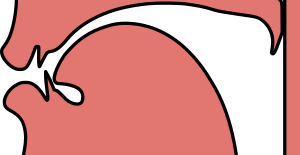Alveolo-palatal consonant facts for kids
| Places of articulation |
|---|
|
Labial |
| Bilabial |
| Labial–velar |
| Labial–coronal |
| Labiodental |
| Dentolabial |
|
Bidental |
|
Coronal |
| Linguolabial |
| Interdental |
| Dental |
| Denti-alveolar |
| Alveolar |
| Postalveolar |
| Palato-alveolar |
| Alveolo-palatal |
| Retroflex |
|
Dorsal |
| Palatal |
| Labial–palatal |
| Velar |
| Uvular |
| Uvular–epiglottal |
|
Radical |
| Pharyngeal |
| Epiglotto-pharyngeal |
| Epiglottal |
|
Glottal |
|
Peripheral |
| Tongue shape |
|
Apical |
| Laminal |
| Subapical |
|
Lateral |
| Sulcal |
|
Palatal |
| Pharyngeal |
|
See also: Manner of articulation |
| This page contains phonetic information in IPA, which may not display correctly in some browsers. [Help] |
|
|
In phonetics, which is the study of speech sounds, alveolo-palatal consonants are special sounds. They are made by placing the blade of your tongue right behind your alveolar ridge (the bumpy part behind your front teeth). At the same time, the middle of your tongue lifts up towards the roof of your mouth, called the palate.
These sounds are often fricatives (like 'sh' or 's') or affricates (like 'ch' or 'j'). They are similar to other sounds called palato-alveolar consonants, but alveolo-palatal sounds have even more of a "palatalized" feel. This means your tongue is raised higher towards the palate.
Sibilant Sounds
Many languages use alveolo-palatal sounds, especially the ones called sibilants. Sibilants are sounds that have a hissing or buzzing quality.
You can find these sounds in many Chinese languages, like Mandarin, Hakka, and Wu. They are also common in other East Asian languages such as Japanese and Korean.
Several slavic languages also use them, including Polish, Russian, and Serbo-Croatian. Even languages like Abkhaz and Ubykh from the Northwest Caucasian languages family have them. The Kinnauri language even has an alveolo-palatal nasal sound.
Here are some examples of alveolo-palatal consonants from the International Phonetic Alphabet (IPA):
| IPA Symbol | What it is | Example | |||
|---|---|---|---|---|---|
| Language | How it's written | IPA | Meaning | ||
| Voiceless alveolo-palatal fricative | Mandarin | 小 (xiǎo) | ' | small | |
| Voiced alveolo-palatal fricative | Polish | zioło | ' | herb | |
| Voiceless alveolo-palatal affricate | Serbo-Croatian | kuća/кућа | ' | house | |
| Voiced alveolo-palatal affricate | Japanese | 地震 (jishin) | ' | earthquake | |
Other Alveolo-Palatal Sounds
Sometimes, experts who study Chinese languages use special symbols for alveolo-palatal sounds that are not sibilants. These include sounds like plosives (stops), nasals, and liquids. However, the official International Phonetic Alphabet (IPA) does not use these specific symbols. Instead, these symbols might sometimes refer to simpler palatal sounds or sounds that are just generally palatalized.
For example, the Polish nasal sound (written with the letter ń) is considered alveolo-palatal, not just palatal. Also, some "palatal" sounds in Indigenous Australian languages are sometimes thought to be closer to alveolo-palatal sounds in how they are made.
Here are some examples of these less common alveolo-palatal sounds:
| Non-standard IPA | What it is | Example | ||||
|---|---|---|---|---|---|---|
| Language | How it's written | Non-standard IPA | Standard IPA | Meaning | ||
| Voiceless alveolo-palatal stop | Korean | Korean: 티끌/tikkeul | ['ʰiʔk̤ɯl] | ['ʰiʔk̤ɯl] | dust | |
| Voiced alveolo-palatal stop | Korean | Korean: 반디/bandi | [b̥ɐn'i] | [b̥ɐn'i] | firefly | |
| Alveolo-palatal nasal | Yi language | ꑌ (nyi) | ' | ' | sit | |
| Alveolo-palatal lateral | Catalan | ull | [ˈu'] | [ˈu'] | eye | |
See Also
- Ladefoged, Peter; Maddieson, Ian (1996). The Sounds of the World's Languages. Oxford: Blackwell. ISBN 0-631-19814-8.


